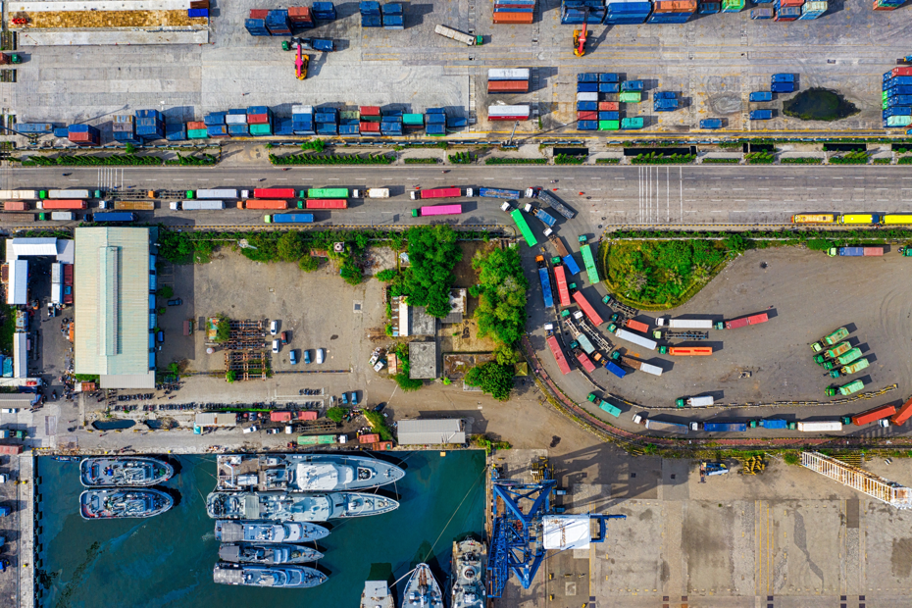COVID-19 has brought pain to millions and wreaked havoc with many, if not most, global supply chains. The invisible is now visible. The pandemic has revealed several layers of supply design and execution failure. Legacy costs and service pressures in Chemical Process Manufacturing, CPG, and durable consumer goods have been compounded by labor surprises, raw material availability, ocean challenges and precision railroading. The uncertainty is increasing inventories and lengthening supply chains.
Underlying geopolitical uncertainty has not waned and the very real global recessions we have entered cast a long shadow. Given all of these challenges, rail is still going to remain the most economical method to move material. Most regions have seen flat or reduced rail volumes as the full impact of the recession may be a quarter or more away. The second quarter has been a disaster in performance.
Since the first moves into China during the early 90’s, the focus has been on supply chain optimization to minimize costs, reduce inventories, and drive up asset utilization. This strategy removed buffers and capacity flexibility to absorb disturbances like COVID-19 and illustrates that many companies are not fully aware of the vulnerability of their supply chain relationships to global shocks.
Companies slashed spending and froze capex but slashing and freezing is not optimizing.
By making short term COVID-19 driven changes to support sourcing and manufacturing changes for new production; and a more strategic approach to the next thirty months, your company will proactively mitigate risk as well significantly support EBITDA. The strategies presented in this article will help you immediately accelerate changes in sourcing and manufacturing, build flexibility and nimbleness in your supply chain and proactively address today’s challenges.
Today’s Challenges – Why You Should Be Concerned
Prior to COVID-19, achieving rail logistics excellence was a significant challenge in most companies. This is because in many companies, logistics is treated as an afterthought. Given the sheer volumes and complexity of transportation modes, many companies spend two to three times the benchmark on logistics, in addition to tying up considerable capital in inventory. This is apparent at both commodity and specialty products providers.
The nature of manufacturing can be complex and often includes synchronized processing of units that ultimately ship product to customers or intermediates to other sites. However, in most cases, logistics planning is not well integrated into the SIOP process. To compensate, manufacturing plants heavily rely on experienced planners at the plant level to ensure they have enough rail or truck supplied raw material and feedstocks, and the right carriers available for customer shipments.
 In general, rail spend is not well managed. Rail assets are treated as a commodity with little to no focus on optimization and overall spend. A typical plant will have an abundance of rail cars sitting for “just in case” scenarios, or in many cases for bulk storage due to poor planning. What companies fail to realize is rail cars are expensive. In addition to lease costs, rail service providers charge hefty demurrage, accessorial and movement changes. Similar dynamics apply to trucking and ocean freight. Without a good overall planning and optimization process, your company is likely spending too much.
In general, rail spend is not well managed. Rail assets are treated as a commodity with little to no focus on optimization and overall spend. A typical plant will have an abundance of rail cars sitting for “just in case” scenarios, or in many cases for bulk storage due to poor planning. What companies fail to realize is rail cars are expensive. In addition to lease costs, rail service providers charge hefty demurrage, accessorial and movement changes. Similar dynamics apply to trucking and ocean freight. Without a good overall planning and optimization process, your company is likely spending too much.
To improve profitability, most rail service providers have moved to a Precision Railroading Model by optimizing rollingstock assets including locomotives, railcars, and crews. While their profits have skyrocketed, companies are now forced to absorb the higher costs and longer car cycle times.
Footprint countermeasures will also trigger new logistics challenges. Ocean Freight movement is going to become more complicated as new material sources in new locations come on-line with different levels of port infrastructure and infrequent ocean list to the three economic zones. Markets face rail and port infrastructure challenges for both raw materials and finished goods. This is further compounded by continued port congestion on the Gulf Coast.
Given new capacity coming online and organic growth, rail transportation in the Gulf Coast is already predicted to be a major bottleneck. This will get even worse as companies move strategic supplies away from Asia. Railroads and ports simply do not have the capability, infrastructure, or capacity to support the region today and shippers are already feeling the impact.

Action Now Is Critical: How the Best Performers are Positioning to Win
Justifying change is now easy. Implementing a new logistics excellence strategy to successfully mitigate these risks while maximizing profitability is critical. The world’s best companies are launching new strategic imperatives including best practice processes, systems, and tools to improve performance visibility, anticipate constraints and optimize logistics to increase profitability and reduce working capital. Common key attributes of these initiatives are discussed below:
1. Re-Shoring strategic segments of manufacturing from Asia to the 3 Economic Zones — The auction like behavior of Chinese suppliers during the height of the COVID-19 supply emergency drove chaotic supply and pricing views of the market and will not be forgotten by procurement professionals any time soon. Companies will need to vet new suppliers both in Asia and in local markets. These suppliers will need to be integrated to the SIOP planning process and must quickly certified by quality, production, and logistics teams so disruptions can be minimized.
2. Think Strategically (Strategy Renewal) – Continually evaluate volatile market dynamics, re-plan and optimize. By pre-planning and conducting early assessments of your overall supply and logistics requirements, you can consolidate freight not only in terms of destination, but across divisions and plants within your organization. Merge existing and select new carriers that understand regulatory requirements for shipping hazardous materials. Decide on a management approach and performance management system and implement it.
3. Integrate Logistics with SIOP – A comprehensive integrated business planning process and approach must reflect a deep understanding of current rail, over the road, and ocean transportation requirements and challenges, as well as opportunities to counter underlying changes in cycle time and costs. Logistics planning and optimization should be fully integrated into your SIOP process and communications. A best practice for transportation logistics involves adopting an “inclusive” approach to your total supply chain.
4. Improve Strategic Partnerships – Recent COVID-19 experience highlights that logistics service providers are critical supply chain partners. Working toward your goals as a team, align on performance metrics, and hold monthly progress reviews. By transforming your providers into crucial links within your supply chain, you can work together towards reducing administrative obstacles, establishing excellent lines of communication, transparency, sharing technologies (such track and trace) and ultimately, lowering costs.
5. Deploy Rail Optimization Best Practices (Both Inside and Outside the Fence) – Implement strategies to right size rail car fleets, optimize car cycle time and cost, improve inside the fence operations, and hold railways accountable for performance. A car cycle time analysis will typically reveal further opportunities to take days and weeks out of the delivery and return cycle by sharing metrics and performance with customers and railways as a method to set standards and avoid fees. Optimize the class one return routing gaps by using triangulation routing to schedule movement of goods during return or repositioning of equipment. Properly managed inside the fence operations will substantially reduce inventories and costs.
6. Implement TMS (Transportation Management System) and Digitize Supply Chain Information – Luckily, supply chain technologies are emerging that dramatically improve visibility across the end-to-end supply chain. Companies need real-time visibility of inbound and outbound materials by carrier type (Rail, Trucking and Ocean) to plan and run their operations. A robust logistics system is essential. A good TMS systems and processes tend to reduce costs 5-10% while improving service for both common carrier and private fleet operations.
7. Deploy Visual Management and Connect the Human Chain – Implement visual performance indicators to anticipate changes and track progress to avoid disruptions and meet customer commitments. Ensure all employees understand what is required and they take ownership. Engage the front line in daily problem-solving meetings to accelerate decision making and ownership. Build teamwork and accountability.
Find the Right Partners to Maximize your Operational Performance
The ARGO-EFESO difference is that we not only develop and implement the right optimized plan for our clients but also create the appropriate behavioral change to sustain performance improvements.
Our four-step approach to operational excellence delivers a company-wide implementation model:
- Access the network, assets, processes, organizational capability and costs
- Jointly develop the new strategy and plan
- Implement work streams to align and prioritize actions to achieve results
- Ensure sustainment and continuous improvement
We believe any model for change must include all employees and must be sustained day in and day out. ARGO-EFESO stays with your company until operational excellence becomes part of the organizational DNA.
ARGO-EFESO helps companies, with significant and complex operating asset structures around the world, improve their profitability by increasing revenue and customer service and satisfaction while reducing operating costs, fixed overhead, and working capital.
ARGO-EFESO’s proprietary business processes and behavior change methods and tools coupled with its deep industry experience and expertise enable us to implement performance improvement more rapidly and sustainably. ARGO-EFESO’s approach to performance improvement is unique in terms of its transfer of knowledge that enhances internal capabilities and its hands-on and collaborative work style with the client.
About the Authors:
Tony Donofrio, Senior Vice President & Partner, ARGO-EFESO Supply Chain Practice. He has over 30 years experience in Retail, Consumer Products/Packaged goods, Pharmaceutical, and Manufacturing industries. [email protected]
Charles Deise, Senior Vice President & Partner, Chemical Process Industries Business Unit. Chuck has over 30 years experience working with Chemical executives to transform operations. [email protected]
Alan Free, Senior Vice President & Partner, is ARGO-EFESO’s Chemicals and Energy Leader. He has over 30 years experience creating value in asset-intensive manufacturing industries. [email protected]
Bruce Work, Vice President, ARGO-EFESO Supply Chain Practice. He has over 25 years experience in Consumer Products/Packaged goods, Retail, Distribution, Pharmaceutical, and Manufacturing industries. [email protected]